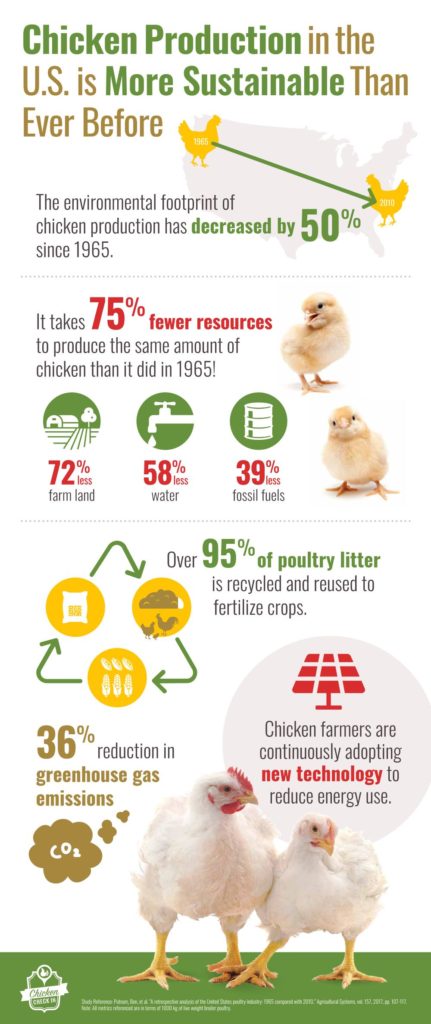Chicken Production in the U.S. is More Sustainable Than Ever Before
Did you know chicken production has a smaller environmental footprint than almost any other animal agriculture industry? With the help of technology and improved animal husbandry practices, chicken farmers have significantly reduced the use of water, farmland, electricity, greenhouse gas emissions, and other valuable resources.
In fact, producing the same amount of chicken today as 1965 has 50% less impact on the environment. Many factors have contributed to the reduced environmental impact of producing chicken1, including:
- 75% fewer resources required in poultry production;
- 36% reduced impact of poultry production on greenhouse gas emissions;
- 72% decrease in farm land used in poultry production; and
- 58% decrease in water used in poultry production.

With improvements in environmental impact comes improvements in bird health and welfare. All current measurable data – livability, disease, condemnation, digestive and leg health – reflect that the national broiler flock is healthier than it has ever been.
Considering U.S. farmers raise 9 billion chickens a year, consumers often have questions and concerns about, you guessed it…what happens to all that chicken poop? Surely the millions of pounds of manure produced by chickens are hurting our planet’s natural resources, right? Wrong. Chicken “litter,” or poultry “litter,” as it’s called in the farming industry, is NOT a waste product! In fact, it is an extremely valuable resource in agriculture.
In 2010, over 95% of broiler poultry litter was recycled. Farmers collect and store poultry litter to be used as an organic fertilizer for crops. Plants feed the chickens and chickens fertilize the plants – it’s a closed, sustainable nutrient loop.
In addition, farmers are required, by law, to follow what are called “Nutrient Management Plans” when fertilizing crops and managing animal manure. These plans specify how much fertilizer, manure or other nutrient sources may be safely applied to crops to achieve yields and prevent excess nutrients from impacting waterways. These Nutrient Management Plans protect water quality by ensuring that farmers and urban land managers apply fertilizers, animal manure and other nutrient sources in an effective and environmentally sound manner.
Today, farmers reduce their environmental impact by more precisely managing and tailoring the feed that is given to the flock through each stage of life. By raising healthier birds and instituting nutrition plans, the amount of feed necessary to raise a chicken has decreased by roughly 40% since 1965. This is known as feed conversion and chicken has one of the best rates in all of US animal agriculture! A better feed conversion means fewer resources are necessary to ensure farmers can raise a healthier flock. Considering our national broiler flock eats about 57 million tons of feed per year – that is a lot of resources saved. Did you know each broiler chicken feeds 4X as many people as one did 60 years ago?
Farmers also minimize water runoff and emissions by planting vegetative buffers between chicken houses, which help to absorb any water, dust or emissions on the farm. And, farmers install heavy use area concrete pads (HUA pads) around the entrances to each growout house to keep litter from being washed away. Litter that farmers do not immediately use is placed in a shed which further ensures that the litter does not enter local water sources.
It takes a healthy planet, fresh water, fertile soil and clean air to raise and produce chicken.
The chicken industry is committed to environmentally responsible and sustainable chicken production practices to ensure a healthier planet. For our farmers, sustainability means being responsible stewards of land, water and feed management, and maintaining and advocating for the humane treatment of our most important asset: our chickens, which we raise to feed families like yours across our nation.
1Putnam, Ben, et al. “A retrospective analysis of the United States poultry industry: 1965 compared with 2010.” Agricultural Systems, vol. 157, 2017, pp. 107-17.
Meet the author, Tom Super, Senior Vice President of Communications at the National Chicken Council.
Super brings 16 years of combined experience in strategic communications, public policy, politics and meat and poultry issues management to NCC’s senior management team. He is responsible for day-to-day media relations, media outreach, social media management and strategic communications planning to supplement the National Chicken Council’s legislative, regulatory and public affairs efforts.
Prior to his joining the National Chicken Council, Super spent three and a half years at the American Meat Institute, most recently as vice president of public affairs. He previously spent six years at Greener and Hook LLC, a Washington-based strategic communications consulting firm where his focus was on planning and executing communications strategies and delivering strategic communications and media relations counsel to corporations, trade associations, ad-hoc organizations, non-profits and political candidates at the local, state and federal levels. Super began his career in Washington, D.C. on Capitol Hill as a press assistant and legislative correspondent for U.S. Senator John W. Warner (R-Va.).
A graduate of Washington & Lee University, in Lexington, Va., Super earned his bachelor of arts degree in public policy.
